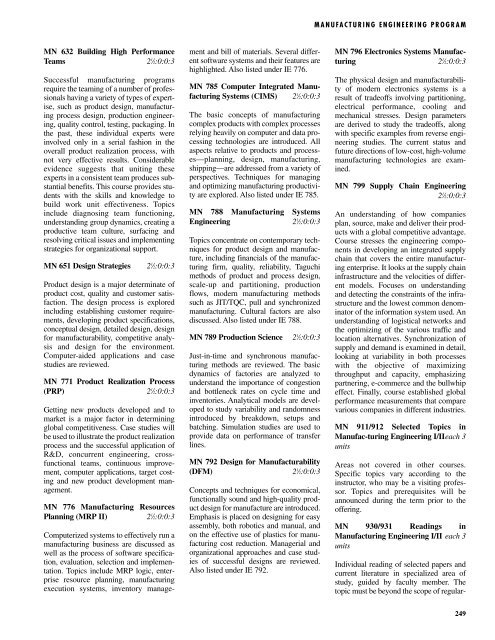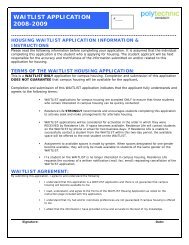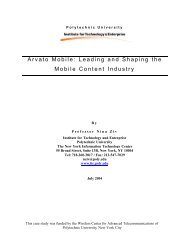POLYTECHNIC UNIVERSITY 2005-2007
POLYTECHNIC UNIVERSITY 2005-2007
POLYTECHNIC UNIVERSITY 2005-2007
You also want an ePaper? Increase the reach of your titles
YUMPU automatically turns print PDFs into web optimized ePapers that Google loves.
MANUFACTURING ENGINEERING PROGRAM<br />
MN 632 Building High Performance<br />
Teams 2 1 ⁄2:0:0:3<br />
Successful manufacturing programs<br />
require the teaming of a number of professionals<br />
having a variety of types of expertise,<br />
such as product design, manufacturing<br />
process design, production engineering,<br />
quality control, testing, packaging. In<br />
the past, these individual experts were<br />
involved only in a serial fashion in the<br />
overall product realization process, with<br />
not very effective results. Considerable<br />
evidence suggests that uniting these<br />
experts in a consistent team produces substantial<br />
benefits. This course provides students<br />
with the skills and knowledge to<br />
build work unit effectiveness. Topics<br />
include diagnosing team functioning,<br />
understanding group dynamics, creating a<br />
productive team culture, surfacing and<br />
resolving critical issues and implementing<br />
strategies for organizational support.<br />
MN 651 Design Strategies 2 1 ⁄2:0:0:3<br />
Product design is a major determinate of<br />
product cost, quality and customer satisfaction.<br />
The design process is explored<br />
including establishing customer requirements,<br />
developing product specifications,<br />
conceptual design, detailed design, design<br />
for manufacturability, competitive analysis<br />
and design for the environment.<br />
Computer-aided applications and case<br />
studies are reviewed.<br />
MN 771 Product Realization Process<br />
(PRP) 2 1 ⁄2:0:0:3<br />
Getting new products developed and to<br />
market is a major factor in determining<br />
global competitiveness. Case studies will<br />
be used to illustrate the product realization<br />
process and the successful application of<br />
R&D, concurrent engineering, crossfunctional<br />
teams, continuous improvement,<br />
computer applications, target costing<br />
and new product development management.<br />
MN 776 Manufacturing Resources<br />
Planning (MRP II) 2 1 ⁄2:0:0:3<br />
Computerized systems to effectively run a<br />
manufacturing business are discussed as<br />
well as the process of software specification,<br />
evaluation, selection and implementation.<br />
Topics include MRP logic, enterprise<br />
resource planning, manufacturing<br />
execution systems, inventory management<br />
and bill of materials. Several different<br />
software systems and their features are<br />
highlighted. Also listed under IE 776.<br />
MN 785 Computer Integrated Manufacturing<br />
Systems (CIMS) 2 1 ⁄2:0:0:3<br />
The basic concepts of manufacturing<br />
complex products with complex processes<br />
relying heavily on computer and data processing<br />
technologies are introduced. All<br />
aspects relative to products and processes—planning,<br />
design, manufacturing,<br />
shipping—are addressed from a variety of<br />
perspectives. Techniques for managing<br />
and optimizing manufacturing productivity<br />
are explored. Also listed under IE 785.<br />
MN 788 Manufacturing Systems<br />
Engineering 2 1 ⁄2:0:0:3<br />
Topics concentrate on contemporary techniques<br />
for product design and manufacture,<br />
including financials of the manufacturing<br />
firm, quality, reliability, Taguchi<br />
methods of product and process design,<br />
scale-up and partitioning, production<br />
flows, modern manufacturing methods<br />
such as JIT/TQC, pull and synchronized<br />
manufacturing. Cultural factors are also<br />
discussed. Also listed under IE 788.<br />
MN 789 Production Science 2 1 ⁄2:0:0:3<br />
Just-in-time and synchronous manufacturing<br />
methods are reviewed. The basic<br />
dynamics of factories are analyzed to<br />
understand the importance of congestion<br />
and bottleneck rates on cycle time and<br />
inventories. Analytical models are developed<br />
to study variability and randomness<br />
introduced by breakdown, setups and<br />
batching. Simulation studies are used to<br />
provide data on performance of transfer<br />
lines.<br />
MN 792 Design for Manufacturability<br />
(DFM) 2 1 ⁄2:0:0:3<br />
Concepts and techniques for economical,<br />
functionally sound and high-quality product<br />
design for manufacture are introduced.<br />
Emphasis is placed on designing for easy<br />
assembly, both robotics and manual, and<br />
on the effective use of plastics for manufacturing<br />
cost reduction. Managerial and<br />
organizational approaches and case studies<br />
of successful designs are reviewed.<br />
Also listed under IE 792.<br />
MN 796 Electronics Systems Manufacturing<br />
2 1 ⁄2:0:0:3<br />
The physical design and manufacturability<br />
of modern electronics systems is a<br />
result of tradeoffs involving partitioning,<br />
electrical performance, cooling and<br />
mechanical stresses. Design parameters<br />
are derived to study the tradeoffs, along<br />
with specific examples from reverse engineering<br />
studies. The current status and<br />
future directions of low-cost, high-volume<br />
manufacturing technologies are examined.<br />
MN 799 Supply Chain Engineering<br />
2 1 ⁄2:0:0:3<br />
An understanding of how companies<br />
plan, source, make and deliver their products<br />
with a global competitive advantage.<br />
Course stresses the engineering components<br />
in developing an integrated supply<br />
chain that covers the entire manufacturing<br />
enterprise. It looks at the supply chain<br />
infrastructure and the velocities of different<br />
models. Focuses on understanding<br />
and detecting the constraints of the infrastructure<br />
and the lowest common denominator<br />
of the information system used. An<br />
understanding of logistical networks and<br />
the optimizing of the various traffic and<br />
location alternatives. Synchronization of<br />
supply and demand is examined in detail,<br />
looking at variability in both processes<br />
with the objective of maximizing<br />
throughput and capacity, emphasizing<br />
partnering, e-commerce and the bullwhip<br />
effect. Finally, course established global<br />
performance measurements that compare<br />
various companies in different industries.<br />
MN 911/912 Selected Topics in<br />
Manufac-turing Engineering I/IIeach 3<br />
units<br />
Areas not covered in other courses.<br />
Specific topics vary according to the<br />
instructor, who may be a visiting professor.<br />
Topics and prerequisites will be<br />
announced during the term prior to the<br />
offering.<br />
MN 930/931 Readings in<br />
Manufacturing Engineering I/II each 3<br />
units<br />
Individual reading of selected papers and<br />
current literature in specialized area of<br />
study, guided by faculty member. The<br />
topic must be beyond the scope of regular-<br />
249




